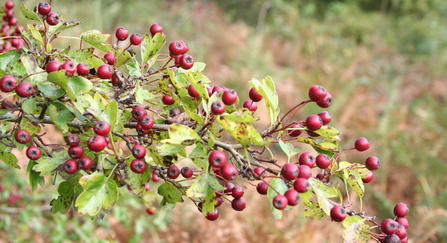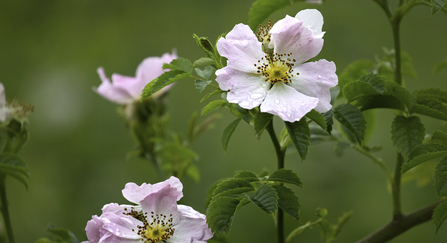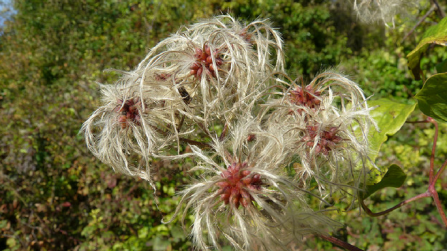
Team Wilder story: Greening Chinnor

Imagine a wilder world on your doorstep, with more nature everywhere in urban and rural areas. That's why residents of Chinnor started Greening Chinnor, a community-led volunteer organisation dedicated to improving the environment and sustainability of the parish of Chinnor and the surrounding areas. A great example of Team Wilder.
Last year, Katie Horgan, BBOWT’s Rough Around the Edges project officer, led some simple survey sessions. The group now has their own survey team and are regularly monitoring and recording new species. Christine Davis explains what they found when the group started clearing an old, neglected orchard to give it a new lease of life.
Five years ago, if you went for a walk up Donkey Lane and crossed the railway line, you would have noticed a wild scrubby patch of land on your right. A quick glance would have shown thick brambles and ivy growing around some struggling trees, and dense undergrowth dominated by nettles. In April there was a scattering of blossom, and then in autumn glimpses of fruit in the higher branches, revealing that someone once planted apple trees there.
Since Greening Chinnor began to selectively clear the area in 2019, it has been a revelation to see just how many species of plants have sprung up from seeds which have been resting in the dark soil. Seeds can lie dormant for many decades until the ground is disturbed and light is let in. It is very likely that at least some of the plants we find there today are descendants of plants which were growing there when people lived on the site.
We carried out monthly surveys of the flowering plants between May and September last year. A flowering plant does not have to be in flower to be counted but it is one which will flower at some time. The following article will give you an idea of the range of plant species that we counted, which added up to 75 in all. In addition, a different survey had been made earlier in March, just looking at the non-flowering species. This revealed some 34 mosses, lichens, fungi and one liverwort. So overall the flora found so far comprises more than 100 species, a quite astounding number.

Hawthorn berries by Philip Precey
Firstly, the trees and shrubs. Besides some 20 apples and a plum, we have ash, elder, elm, hawthorn, holly, and spindle. The elms remind us of the former large specimens on the southern boundary, which feature in early postcards of the site, sadly now gone from the landscape. Smaller elm trees still growing in the orchard are just clinging on with their upper branches dying once they reach a certain height. Other stumps on the old boundary hedge have sent up elm suckers. Ash saplings have sprung up where the light has been allowed in, especially near to the fine healthy specimen on the southern boundary.
Then there are quite a variety of 'climbers', all creeping up and over the trees if allowed. These include the woody traveller's joy or old man's beard (the wild clematis) and ivy, woody nightshade, and the scrambling white bryony or 'English mandrake'. There are also the weak-stemmed cleavers whose sticky fruits are so good at attaching themselves to your sleeves, and the hedge bindweed with its delicate white flowers which close in poor weather.
Next there are some 'woodland' species, plants that are normally found in native or older woods and hedges. These include 'lords and ladies', stinking iris and hedge woundwort. They may indicate former woodland on the site before the houses were built, or they could have travelled down the hill from the wooded Chiltern slopes above.

Dog rose. Photo by Jon Hawkins - Surrey Hills Photography
The 'wayside flowers’ are those you might see on a country walk, including dog rose, black medick (a relative of clover with small yellow flowers), hogweed, and the pretty white cow parsley or, as I prefer to call it, Queen Anne's lace. Plants typically found on ‘waste land' include four species of thistle, mugwort, and the lesser burdock.
Looking at those species usually known as 'weeds of cultivation', most of these are familiar to anyone who has a garden or allotment, even if you don't know what they are called. Plants such as groundsel, dandelion, shepherd's purse and creeping buttercup fall into this group. But there are also some farmland ‘arable weeds’ such as twitch grass (a serious weed of agriculture) and scentless mayweed, which will have come in from the neighbouring fields.
Grasses are well represented with around ten different species: they are quite hard to identify unless they are in flower. Some are arable weeds but others are species which we happily allow to grow in our garden lawns. Another grass we have in the orchard was formerly planted as a valuable grazing and hay grass, called perennial rye grass. It has been cultivated in England for some 300 years with different strains being selected by farmers and plant breeders. So useful, in fact, that in the past seeds were collected and taken to the Americas, Australia and New Zealand.

Wild clematis or old man's beard. Photo by GanMed64/flickr.com
White mustard was found, as an escape from nearby field cultivation. We saw a couple of tomato plants, perhaps arising from the remains of a summer picnic. Finally, there were some ‘garden escapes’. The yellow-flowered mock strawberry - which I have never seen before - was probably brought in by birds in their droppings. It was introduced to the UK in 1804 when apparently there was a craze for using it in hanging baskets during the Regency period - who knew? Finally, the most unexpected find - a pretty plant with red foliage and delicate pink flowers which turned out to be verbena 'Bampton'. This is a relatively new garden variety of the magical wild vervain (which does grow on nearby Chiltern grasslands) and it has been on sale in nurseries only since about 2010. Possibly introduced via a bird from one of our keen 'Chinnor Open Gardeners', who may have been one of the first to buy this new garden plant!
In 2022 we will again be surveying, but this time on a more scientific basis, with our results being sent off digitally to inform the wider world of our floral findings in the orchard. Fingers crossed that we find even more species to add to our list.
Christine Davis, Greening Chinnor
If you're part of a community group working for wildlife in your area we'd love to hear from you. Add a pin to our interactive map and tell us what you're doing.
Stay up-to-date with our work
Sign up below to receive the latest news from BBOWT, tips about how you can help wildlife, plus information on how you can get involved.

